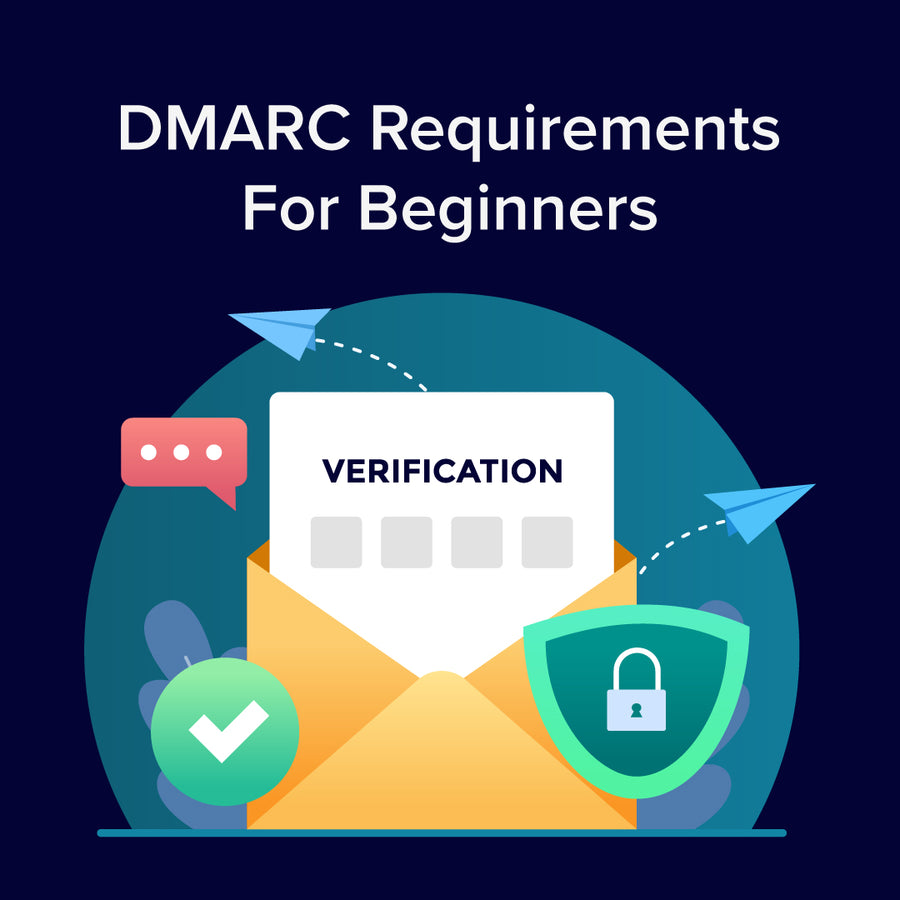Understanding the New Gmail and Yahoo DMARC Requirements: A Guide for Beginners
5 February 2024

This article provides a clear and comprehensive understanding of the new DMARC requirements for Gmail and Yahoo for beginners. It covers the essential aspects of DMARC, its importance, and practical steps for implementation, ensuring you are well-informed and prepared for these changes.
Email security and deliverability is a critical concern in today's digital world, and recent updates from Gmail and Yahoo requiring bulk senders to implement DMARC have brought it into the spotlight. Let's dive into the new requirements set by these email giants, and just what Domain-based Message Authentication, Reporting, and Conformance (DMARC) is.
Specific DMARC Requirements by Gmail and Yahoo
Starting February 2024, Gmail and Yahoo will require bulk senders (those sending over 5,000 emails a day) to have a DMARC policy in their DNS. Emails must pass DMARC alignment, meaning they must align with either the DKIM or SPF standards. This change is aimed at improving email security and reducing spam.
What is DMARC and Why is it Important?
DMARC is an email authentication protocol designed to give email domain owners the ability to protect their domain from unauthorised use, commonly known as email spoofing. The purpose and importance of DMARC is to ensure that genuine emails are correctly authenticated against established DKIM (DomainKeys Identified Mail) and SPF (Sender Policy Framework) standards, providing an additional layer of security.
Impact on Email Senders and Receivers
For senders, particularly those who send bulk emails, this means ensuring their email sending practices align with DMARC policies. Failure to comply could lead to emails being rejected or marked as spam. For receivers, this will likely mean a decrease in spam and phishing emails, making their inboxes safer and more secure.
Benefits of Complying with DMARC
Compliance with DMARC helps in enhancing the reputation of the sender's domain, reducing the risk of phishing attacks, and improving email deliverability. It also provides insights into email channels, which can be used to identify and fix email delivery issues.
Challenges in Implementing DMARC
Organisations often face challenges in correctly configuring DMARC records, understanding DMARC reports, and ensuring that all legitimate email sources are authenticated. It requires ongoing management and adjustments to maintain compliance.
Best Practices for DMARC Configuration
- Start with a monitoring policy (p=none) to understand your email ecosystem.
- Gradually move to a quarantine policy (p=quarantine) and finally to a reject policy (p=reject).
- Regularly monitor and analyse DMARC reports to identify and authorise legitimate email sources.
Interpreting DMARC Reports
DMARC reports provide valuable data on who is sending emails on behalf of your domain. Understanding these reports is crucial for identifying unauthorised use and taking corrective actions.
Ensuring Successful Email Delivery
To ensure successful email delivery:
- Regularly check and update SPF and DKIM records.
- Monitor DMARC reports for any delivery issues.
- Engage with email service providers to resolve any authentication problems.
Resources and Tools for DMARC Implementation
Various tools and services can assist in DMARC implementation, including DMARC analysers and reporting tools. These can simplify the process of setting up and monitoring DMARC records.
Here are some tools you might find useful:
Conclusion
The new DMARC requirements by Gmail and Yahoo mark a significant step towards a more secure email ecosystem. By understanding and implementing these requirements, organisations can not only comply with these new standards but also enhance their overall email security posture.
Contact Us to discuss how we can help increase sales and boost your online performance!
INSIGHTS
CASE STUDIES

Fired Earth - Shopify Plus
Fired Earth’s move to Shopify Plus marked a major transformation for their B2C and B2B operations, streamlining their product catalogue and delivering a faster, more adaptable eCommerce experience, supporting growth and enhanced customer engagement.
-
Shopify

Carluccio's Coffee Subscription
Discover how we helped Carluccio’s transform their online coffee products, creating a bespoke design, unique user journey and efficient user experience, resulting in an eye-catching subscription service, seamlessly integrated with their Shopify site.
-
Shopify
CONTACT
Are you excited to get your next project up and running? Or are you unsure what is dragging you down?
Contact Us to discuss how we can help increase sales and boost your online performance!

Enter your email address to sign up to our newsletter, featuring case studies, insights, industry news and much more.
If this is something you would like help with, please get in touch.







